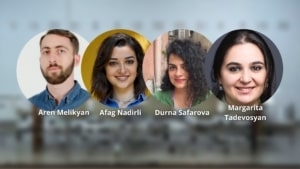
Media, including mass and social media, are the means through which conflict discourses – the image of self and enemy – are constructed and (re)produced. Media do not simply transmit reality as it happens. Even the most impartial media sources are selective and therefore subjective: they represent a particular ideology, a particular lens, a particular slice of reality. In other words, what we receive through media is inevitably a representation of an event and not the event itself.
The speakers of Caucasus Edition’s August webinar “Media and Conflict Discourses”, Aren Melikyan, Afag Nadirli, Durna Safarova, and Margarita Tadevosyan took a close and critical look at the media coverage and social media campaigns during the Second Karabakh war and its aftermath.
Durna Safarova, filmmaker, journalist, media manager at ChaiKhana Media, and regular contributor to Eurasianet.org, sees censorship as one of the primary problems facing journalism in Azerbaijan. Within the nation, censorship presents in varied forms ranging from officially imposed sanctions to financial patronage. As a result, the audience directs its attention to small alternative media sources and foreign media platforms.Aren Melikyan is a journalist and a podcast producer who has worked at RFE/RL, Chai-Khana.org and other media outlets, and bylined for CNN Digital and BBC World Service during the Second Karabakh war. Melikyan sees journalists’ unprofessionalism as one of the main problems within the Armenian media landscape. To him, journalists in Armenia are trained to serve the national interests of the state and fail to differentiate between patriotism and professional journalism. Many of them wore military uniforms during their coverage of the war to express their support to the Armenian army. As a result, instead of trying to cover the war as objectively as possible, journalists became part of it. Additionally, many media outlets used vocabulary that normalized the war. Melikyan says, “We got used to it. It started to feel like a weather broadcast. But being used to it and accepting it as normal are different things.”
Disinformation – A Weapon in the Era of New Wars
Both Safarova and Melikyan highlighted the abundance of disinformation in both mass media and social media. In Armenia, says Melikyan, the opposition-owned media actively spread disinformation for political reasons.
To illustrate the abundance of disinformation during the Second Karabakh War, Safarova referred to a recent report titled “Paper on False Information: About the Azerbaijan-Armenian Conflict” by Teyit, a Turkish fact-checking agency. According to the report, during the war 69.9% of the claims made related to the Nagorno-Karabakh conflict included false images associated with unrelated events. The fake news included statements such as “Armenian soldiers fed the dead Azerbaijani soldiers to pigs” and the claim that “The Armenian flag was reflected on buildings in Dubai.”
Safarova also notes that journalists usually do not fact-check their work, yet they collect information for their reports on social media, which most of the time is fake news.
Social Media: The New Battlefield
Afag Nadirli, independent consultant and peace and development researcher, and Margarita Tadevosyan, post-doctoral research faculty at Jimmy and Rosalynn Carter School for Peace and Conflict Resolution at George Mason University, presented their findings on the social media landscape in Azerbaijan and Armenia.
Nadirli and her team monitored close to 60 social media pages on Facebook and Youtube. The main finding was that in Azerbaijan and in Armenia discussion of the same conflict revolved around completely different agendas. In Azerbaijani online space, the topic of internally displaced people was the most frequently discussed. In the Armenian online space, the topic of POWs was discussed most often.
Margarita Tadevosyan analysed hashtag activism in the Armenian social media space. She focused on the most popular hashtag during the war, #հաղթելուենք (#wewillwin). The hashtag, used in Armenian script, was very popular and was used on TV screens, on posters and other media. In comparison to other hashtags popular among the Armenian audience, such as #stopAzerbaijaniagression, #stopErdogan, #Artakhstrong, which functioned to call the international community to action, raise awareness, and for fundraising purposes, #wewillwin was intended for the internal, Armenian speaking audience only. 240 respondents in Tadevosyan’s research, regardless of their age, gender, and background actively used the hashtag, which was a way for people to participate in co-creating the conflict narrative. The hashtag, as well as other propaganda materials, were spread through organized online groups, such as the Armenian Cyber Army which has more than 8,000 active members. The groups organized to refute the information coming from the Azerbaijani side and promote their version of events as “The Truth.” Members of such groups presented themselves as “cyber-soldiers.” This signifies how the social media space plays a crucial role in modern warfare.
Why Peace Discourse is Unpopular and Next Steps
Nadirli mentions there are several social media platforms that were created during the war, such as the Russian-language “Caucasus Crossroad”, that enabled people from the two sides of the conflict to get to know each other and engage in dialogue. Nadirli believes that there is a need to support and actively engage with such initiatives in order to foster peace discourse.
Tadevosyan believes that the unpopularity of peace discourse is primarily caused by a lack of understanding of the term “peace.” She argued, “… thinking about war, you understand what war is – bullets, tanks, people killed. When it comes to peace and reconciliation – those are vague concepts within public and political discourse. There has never been a conversation about it, so people don’t make sense of what they mean.”
The main takeaway from the discussion was the need for strong media literacy courses at schools and universities. All speakers agreed that there is a need to educate young social media users how to navigate through the vast amount of information, as it is impossible for fact-checking agencies to identify all flows of disinformation. It is also equally important to train journalists on both sides to use fact-checking tools to avoid reproducing disinformation and becoming part of cyber warfare.